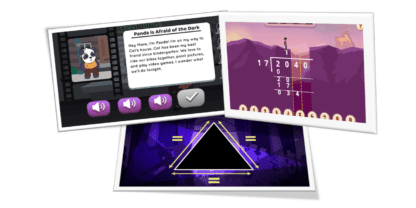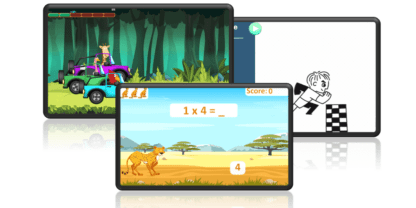Reading is in bad shape, but there’s no better time than National Family Literacy Month to examine the issues and take steps in the right direction.
As of 2020, the percentage of U.S. students who report reading for fun continued a decades-long downward trend (NAEP via Pew Research) across all sampled ages and grade levels. Most disturbingly, the percentage of students who report reading for fun “never or hardly ever” has overtaken the percentage of students who report reading for fun “almost every day” among older students (13-17-year-olds).
Of course, parents play a huge role in this. Although research in the current, always-connected environment is limited, there is ample evidence that parental involvement (especially the academic expectations parents have for their children) has an outsized impact on student outcomes. Literacy is no different. Kids need to know that reading is an option for downtime, and it helps when they can see the behavior modeled in the adults around them. For parents who don’t read for fun, it becomes even more important to emphasize the benefits, the entertainment value, and the availability of good stories.
November’s designation as National Family Literacy Month gives us all an opportunity to focus on reading as an integral part of our lives, not just a classroom expectation. The activities below are meant to help bridge the gap between screen time and book time, and can be enjoyed solo or with an adult.
How do I use this list?
All activities are accessible via the direct link provided—feel free to share these links with students and parents. We have also included a link to the relevant Small Group Skills assignment when available for all of these activities. Current eSparkers can follow the link to the lesson and assign it out to a group of students. Activities not included in Small Group Skills will be encountered by students on their independent pathways in eSpark depending on the level they are working at.
The activities are ordered by grade level—teachers in grades 4-6 are encouraged to skip ahead to the back half of the list.
1) My Pet Llamacorn
- Activity type: Read-aloud story
- Suggested grade level: Pre-K – Kindergarten
- Click here for the Small Group Skill
In this animated read-aloud story, students are introduced to new words and moving illustrations as they meet Fluffy, the llama-unicorn hybrid with magical powers and lots of friends. Students can follow along with the words as they’re being read, and they’ll get good practice turning pages in a digital environment.
2) Describing Connections
- Activity type: Instructional video
- Suggested grade level: Kindergarten
- Click here for the Small Group Skill
This video and its associated Small Group Skill helps young readers develop a framework for making connections between some of the different things they are reading. The Small Group Skill lesson pairs this video with the interactive story My Navajo Taco from Unite for Literacy, making it a timely addition to November units in celebration of Native American Heritage Month.
3) Dakota’s Dog Rescue
- Activity type: Game
- Suggested grade level: 1st
- This game is not included in a Small Group Skill at this time. Click here to access the 1st grade context clues SGS featuring a different activity.
Even after students have started to master the technical aspects of reading, the amount of background knowledge they possess has a significant impact on their ability to comprehend what they’re looking at. In this game, students will practice using context clues to assign meaning to unknown words. eSpark’s Learning Design team is intentional about weaving this kind of vocabulary practice into lessons across the various reading domains whenever possible.
4) Azure Leads the Way
- Activity type: Read-aloud story
- Suggested grade level: 2nd
- Click here for the Small Group Skill
Azure is a fan favorite among eSparkers due to the story’s gorgeous light and color animations. This story will help students use a combination of words and illustrations to demonstrate understanding of characters, setting, and plot. When students finish the story, they are rewarded with the chance to move Azure and her young dragonfly crew around the page.
5) River’s Journal
- Activity type: Interactive text
- Suggested grade level: 3rd
- Click here for the Small Group Skill
In this unique reading activity, students will get a peek inside our friend River’s personal journal. River’s colorful doodles and emotionally charged entries help students understand (and eventually describe) characters, including their traits, motivations, feelings, and how their actions contribute to the sequence of events. It’s a welcome break from the typical literature/informational text split and provides an entry point for students who can better relate to a more personal form of storytelling.
6) An Unexpected Lesson
- Activity type: Story with prompts
- Suggested grade level: 4th
- Click here for the Small Group Skill
When Aaliyah encounters an unusual, caped stranger at the bus stop, she is unsure how to react. Little does she know, Marvin and his out-of-place conch shell will change her life forever. In this animated story, students are asked to draw on details in the text for supporting evidence at several checkpoints. Students should absorb an important lesson on the value of a positive mindset as their reward for finishing the activity.
7) Making Inferences
- Activity type: Instructional video
- Suggested grade level: 5th
- Click here for the Small Group Skill
Reading is far more than just the words on the page. What does the author tell us explicitly, and what are they implying? In this video students will learn how to combine explicit information with their own experiences to infer feelings, motivations, and character traits. The video includes cameos from the popular book Wonder by R.J. Palacio and the fable of the tortoise and the hare.
8) Relationships and Interactions in Non-Fiction Text
- Activity type: Instructional video
- Suggested grade level: 5th
- Click here for the Small Group Skill
Looking for a cool way to integrate growth mindset into your work on informational reading standards? This video and its companion article help students explain the relationships and interactions between two or more ideas in a scientific text based on specific information in that text. Students will learn how the brain can be developed like a muscle and the concept of “fixed intelligence” is a thing of the past.
9) Dr. Chavez’s Science Lab
- Activity type: Game
- Suggested grade level: 6th
- Click here for the Small Group Skill
Oh no! Dr. Smevil has released a toxic chemical at the zoo and we need to help the animals recover. Students will collect test tubes, then unlock doors by answering questions about text passages. The game is designed to help students become more proficient at citing textual evidence to support analysis of what the text says explicitly, as well as inferences drawn from the text. Can your students save the animals in time?
Literacy will always matter
That much is obvious, but there’s something to be said for shifting the discussion away from the binary “screen time vs. book time” framework and adopting the mindset of “let’s use technology to foster a love of reading.” With eSpark’s combination of interactive stories, memorable instructional videos, and skill-based games, students (and their families) have multiple ways to engage with text and explore the infinite possibilities of the written word in National Family Literacy Month and beyond.
For those who haven’t yet joined the eSpark family, this month presents a grand opportunity to dive in and see for yourself why eSpark is making waves as the “more fun” alternative to traditional supplemental curriculum resources. Students encounter a wide variety of videos, songs, games, and other activities as they learn, practice, and master their math and reading standards—a welcome change from the traditional dry instruction > multiple choice/drag-and-drop > test approach. Teachers can sign up for free using the link below.









